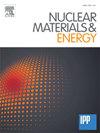辐照损伤对钨材料力学性能影响的实验研究
IF 2.3
2区 物理与天体物理
Q1 NUCLEAR SCIENCE & TECHNOLOGY
引用次数: 0
摘要
钨(W)被认为是未来磁约束聚变反应堆中首选的等离子体表面材料。在那里,它将暴露在高热通量和强烈的中子辐射中。中子辐照会产生脆化效应,预计会引起材料的辐照硬化和脆化,这对钨构件的结构完整性构成了重大威胁。高能自离子辐照可以模拟中子辐照对钨的位移损伤。由于重离子辐射在W中的穿透深度较低,细W线被用作模型系统,因为它们可以在整个体积内照射。这种金属丝的微结构非常精细,可以减小尺寸效应。为了测量重自离子辐照的效果,将直径为16 μm的W线变细至5 μm,然后用20.3 MeV的W6+离子辐照。力学性能是通过拉伸测试和扫描电镜(SEM)成像的面积缩小作为延性的测量。以0.2 dpa, 1 dpa和10 dpa照射10根导线,并与接收材料进行比较。在制造状态下,这些金属丝表现出明显的延展性。辐照损伤没有改变样品的力学性能和面积缩小。本文章由计算机程序翻译,如有差异,请以英文原文为准。
Experimental investigation of the impact of irradiation damages on the mechanical properties of tungsten
Tungsten (W) is considered the preferred plasma-facing material (PFM) in future magnetic confinement fusion reactors. There it will be exposed to high heat fluxes and intense neutron radiation. Neutron irradiation could have an embrittling effect on is expected to cause irradiation hardening and embrittling of the material, which poses a significant threat for the structural integrity of tungsten components. High-energy self-ion irradiation can be used to simulate the displacement damage caused by neutrons irradiation in tungsten. Due to the low penetration depth of heavy ion radiation in W, thin W wires are used as a model system since they can be irradiated throughout their full entire volume. The very fine microstructure of such wires allows size effects to be reduced. To measure the effect of heavy self-ion irradiation, 16 diameter W wires were thinned to 5 and then irradiated with 20.3 MeV ions. Mechanical properties were determined by tensile testing and scanning electron microscopy (SEM) imaging of the area reduction as a measurement for ductility. Ten wires each were irradiated at 0.2 dpa, 1 dpa, and 10 dpa and compared with the as-received material. In the as-fabricated state, these wires show a pronounced ductile behavior. The irradiation damage did not alter the mechanical properties or the area reduction of the samples.
求助全文
通过发布文献求助,成功后即可免费获取论文全文。
去求助
来源期刊

Nuclear Materials and Energy
Materials Science-Materials Science (miscellaneous)
CiteScore
3.70
自引率
15.40%
发文量
175
审稿时长
20 weeks
期刊介绍:
The open-access journal Nuclear Materials and Energy is devoted to the growing field of research for material application in the production of nuclear energy. Nuclear Materials and Energy publishes original research articles of up to 6 pages in length.
 求助内容:
求助内容: 应助结果提醒方式:
应助结果提醒方式:


